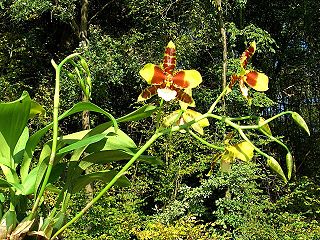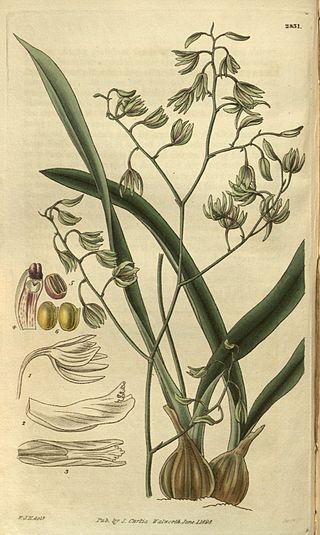
Orchids are plants that belong to the family Orchidaceae, a diverse and widespread group of flowering plants with blooms that are often colourful and fragrant. Orchids are cosmopolitan plants that are found in almost every habitat on Earth except glaciers. The world's richest diversity of orchid genera and species is found in the tropics.

Oncidium, abbreviated as Onc. in the horticultural trade, is a genus that, as of December 2023, contains about 340 species of orchids from the subtribe Oncidiinae of the orchid family Orchidaceae. It is distributed across tropical and subtropical America from Mexico, Central America and the West Indies to northern Argentina, with one species (O. ensatum) extending into Florida. Common names for plants in this genus include dancing-lady orchid and golden shower orchid.

Laelia is a small genus of 25 species in the orchid family (Orchidaceae). Laelia species are found in areas of subtropical or temperate climate in Central and South America, but mostly in Mexico. Laelia is abbreviated L. in the horticultural trade.

Ansellia is considered a monotypic genus of orchid, with only one species, Ansellia africana, commonly known as African ansellia or leopard orchid, however, it may in fact be a complex group of species which share common floral structure and growth habit.

Epidendrum, abbreviated Epi in the horticultural trade, is a large neotropical genus of the orchid family. With more than 1,500 species, some authors describe it as a mega-genus. The genus name refers to its epiphytic growth habit.

Encyclia is a genus of orchids. The genus name comes from Greek enkykleomai, referring to the lateral lobes of the lip which encircle the column. It is abbreviated as E. in the horticultural trade.

Dinema is a genus of orchids. It is represented by a single currently accepted species, Dinema polybulbon, native to Mexico, Central America, and the Caribbean.

Prosthechea is a genus of flowering plants in the orchid family (Orchidaceae). The name is derived from the Greek word prostheke (appendix), referring to the appendage on the back of the column. Appendage orchid is a common name for this genus. Prosthechea is abbreviated Psh. in the horticultural trade.

Houlletia is a genus of large-growing epiphytic orchids native to Mexico, and possibly also Guatemala through Central America to Bolivia. was established with the publication by Brogniartt of Houlletia brocklehurstiana in 1841. The genus is named in honor of orchid collector and grower M. Houllet, French orchid collector in Brazil, later the director of the Botanic Jardin des Plantes in Paris, 19th century.

Rossioglossum grande, one of several species known as tiger orchids, is an epiphytic orchid native to the area from Chiapas to Costa Rica. The plant may grow four to eight flowers, each up to 13 inches in diameter. The flowers are a glossy bright golden yellow with brown barring. Larger petals are yellow with the lower half red-brown. The lip is white and sometimes flecked with red-brown. The pseudobulbs are gray-green in color, and grow from 4 to 10 cm, each with two leaves.

Prosthechea cochleata, commonly referred to as the clamshell orchid or cockleshell orchid, is an epiphytic, sympodial New World orchid native to Central America, the West Indies, Colombia, Venezuela, and southern Florida. It is also known as the black orchid in Belize, where it is the national flower.

Cattleya amethystoglossa is a bifoliate species of orchid from the genus Cattleya.

Brassavola flagellaris is a species of epiphytic orchid of the Cattleya alliance. It grows wild in eastern Brazil, where it fills the evening air with the citrus-like fragrance of its blossoms.

Cattleya maxima is a species of orchid in subfamily Epidendroideae found from Ecuador to Peru.

Encyclia adenocaula is a species of epiphytic orchid of light purple flowers, native to forests in Mexico.

Cattleya cernua, commonly known as the nodding sophronitis, is a species of orchid occurring from Brazil to northeastern Argentina. It was the type species of the genus Sophronitis until the genus was made synonymous with Cattleya. Twenty plants of C. cernua have received a total of 22 AOS awards. The described flowers range from 1.9 cm to 3.2 cm horizontal spread and from 2.0 cm to 3.0 cm vertical spread.

Cattleya rex is a species of epiphytic orchid of showy white flowers, native to montane forests in Peru and Bolivia.

Prosthechea citrina, synonym Encyclia citrina, is a species of orchid native to southwest Mexico. It is known as tulip orchid and has a strong lemon fragrance. Its petals are golden yellow with varying degrees of white crenulations in the lip. The plant may be upright or pendant, but the flowers are always pendant. It is also known as the tulip orchid due to its flowers' rounded cup-like shape. It has been referred to for generations as costicoatzontecoxòchitl, meaning "flower in the form of yellow serpent head", by the Nahuas.

Encyclia viridiflora is a species of epiphytic orchid of green flowers, native to the north of Brazil and is the type species for the genus Encyclia. Especially the specimen was found in the area of Rio de Janeiro.

Encyclia advena is a species of epiphytic orchid, native to Atlantic forests in Brazil.
























